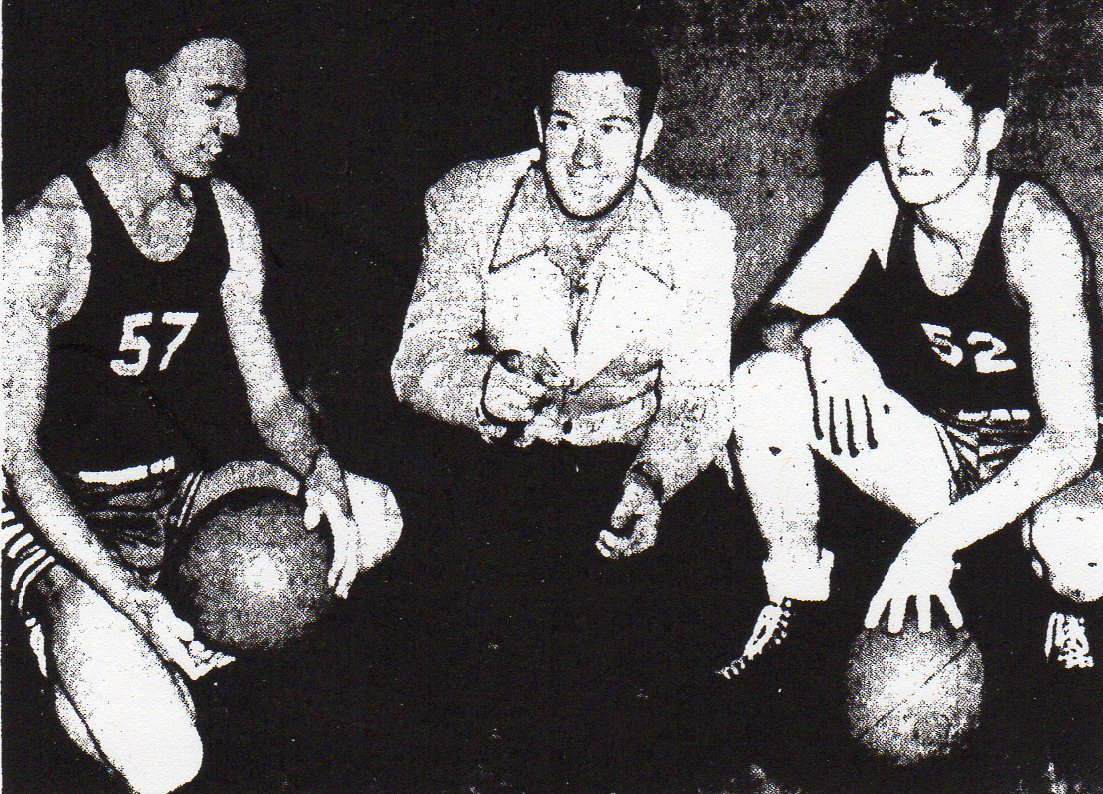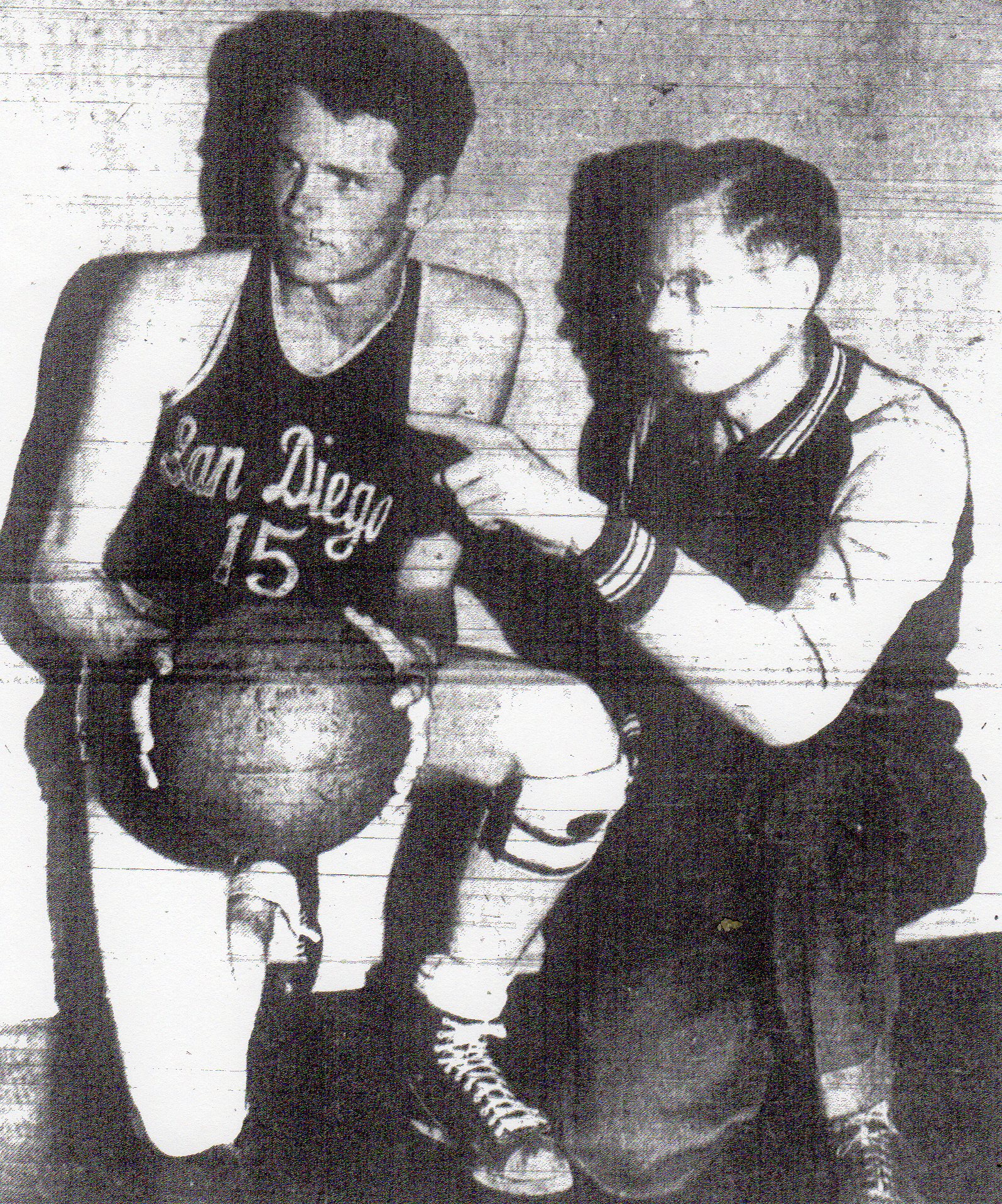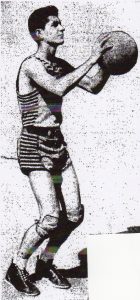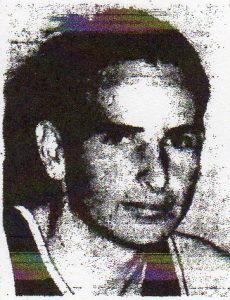Galvanized Americans had Victory on their minds as the war moved into its second year.
San Diego school officials, living in the hub of the defense industry, pitched in. They created the Victory League and put the Metropolitan League in a basketball drydock.
Call theirs a New Year’s Resolution.
Coronado coach Hal Niedermeyer had announced a Metro schedule of one round of nine games on December 10.
But on Jan. 12, when play got under way, the circuit had a new name, a positive acknowledgement of Uncle Sam’s rallying cry for Victory in Europe and Japan.
The Metro, born in 1933 and inclusive of the city’s and suburbs’ smaller schools, would not return until after the 1945-46 academic year.

OFF ROAD?
Low fuel tanks and balding tires were by-products of the need for precious wartime materials.
Necessary gas rationing and travel restrictions were such that the league did not include all members who competed in the similar Metropolitan loop during football season.
Victory travel would be by streetcar or bus.
Suburban Sweetwater and rural Escondido and Oceanside were forced to bail.
Night games were at the option of host schools.
As they did in football for the 1942 season, local titans San Diego High and Hoover split their squads. Four teams included the San Diego Blues and Whites and the Hoover Reds and Whites.
WE GOT GAME
Military personnel and defense workers needed outlets, free of the stressful demands of their jobs.
Dozens of basketball teams were formed.
Some were unique, such as the Spot Welders of the Solar Day Shift League.
There also were teams named the Balloon Battalion, B-24 Fuselage, Machine Shop, Tool Controls, Bombing 12, Naval Air Personnel, 10th Replacement Center, Armed Guard, and Submarine Repair.
Not to mention Naval Training Station Dental Clinic, Provisional Battalion, the Elliott Leathernecks, Point Loma Radio School, and the Solar Aircraft Dawn Patrol.
And more.

MY ALMA MATER
Several months after graduation at San Diego and before he entered the military, Ermer Robinson still had his game.
Robinson scored 17 points, including the winning free throw with 20 seconds remaining as the Alumni defeated the San Diego varsity, 30-29, in one of the few December games throughout the County.
Frank Pietila played for the Hilltoppers varsity while his brother Paul was on the Alumni B team that lost to the school B’s, 38-32.
SHRILL WHISTLES
Earl Keller of The Tribune-Sun pulled no punches.
“In a game that was all but ruined by over officiating on the part of Pete Burk and Don Clarkson, Herbert Hoover’s cagers scored a last-minute, 34-33 win in their city championship series opener over San Diego High before an overflow crowd in the Hiller gym,” wrote Keller.
Burk and Clarkson called 29 fouls “and had the players afraid to breathe,” noted the scribe, incidentally a San Diego High graduate.
Leo Tuck, who would be a midterm graduate the following week and later played at San Diego State, emerged from a crowd under the basket to score and give the Hoover varsity a 34-33 victory.
The combined teams would meet twice during the season and the rival split squads would meet four times.
San Diego won the second game between the combined teams, 35-25, and the varsity, Blues, and Whites were 5-1 against Hoover, counting all games.
A’s AND B’s
San Diego’s split squads won the Class A title with a 13-1 record, the Whites going 7-0 and the Blues 6-1, the only blemish a 33-32 loss to Point Loma.
Against all competition, San Diego was 17-6, including Blues and Whites combined teams.
One of the combined team losses was 42-32 to Camp Callan, a rugged Army anti-aircraft squad that scored more than 100 points against multiple service teams.
The Hoover Class B team, a power and school favorite for a decade, won that classification with a 12-2 record. The Cardinals’ combined Reds and Whites were 10-4, and 11-4 against all competition.
KEEPING IT IN FAMILY

Johnny Correia of Point Loma scored a running set shot from near the half-court line in the final seconds of a 38-25 loss to Hoover to finish with 16 points and earn his second straight Victory scoring title.
Correia, who had 102 points in league play, was joined on the all-Victory League team by Hoover’s Don Nuttall, who had 101 points.
Other first-team choices were the Cardinals’ Don Smith and San Diego’s Sal Gumina and Jim Glasson, who also was all-Southern Section third team.
Correia’s brother Frank made the Victory second team and cousin Ed was on the B first team.
KEEPING IT IN FAMILY II
San Diego High midterm graduate Frank Pietila was on the second all-Victory League team and played municipal and AAU basketball for years in San Diego.
Pietila’s son, Ron, played professional baseball after graduating from Sweetwater and became an honored coach in San Diego and throughout California, known as the “Godfather of Girls Soccer.”
Frank, who coached youth baseball and scouted talent for major league baseball teams, also is the great grandfather of Micah Pietila-Wiggs, who starred on Chula Vista’s 2013 Eastlake team that won the Little League World Championship.
WHAT’S YOUR TRADE?
San Diego Vocational, which opened in September, 1941, fielded a team and joined the Victory League when Sweetwater, Oceanside, and Escondido backed out.
Vocational competed in most sports except football before being merged after the 1954-55 school year into technical and shop departments at San Diego High.
The school was aligned with San Diego JC before moving to a more permanent location at State and Market streets in downtown San Diego in 1948.

SET SHOTS
So he didn’t mistake one for the other, San Diego coach Merrill Douglas asked brothers Mitch and Ben Rosenthal to get different style haircuts…Vocational’s first victory was 58-45 over a team known as the “Mission Beach Champs” as Larry Hansen scored 22 points…Sweetwater developed an intra-school team competition in which every boy enrolled was invited…success of the Victory League in football and basketball encouraged participation in spring sports; principals met at Hoover on Feb. 16 and decided to go ahead with baseball and track, with a precautionary “Only necessary travel to games would be permitted,” said La Jolla principal Dr. Earl Andreen…after winning eight consecutive practice games, La Jolla flattened out to 9-7…former Escondido football coach Harry Wexler, who coached a military team in 1941-42, was Vocational’s coach…teams that did not have campus gymnasiums and played on outdoor courts, were able to access the San Diego gym when the Blues and Whites were playing elsewhere…Point Loma defeated Grossmont, 26-17, for its first victory over the Foothillers since 1938…the San Diego County Officials’ Association announced that any surplus money from the season would be turned over to war bonds….

Here’s a little chuckle for you; speaking of the “Elliott Leathernecks” in your post, I was one in 1957.
Attached pic [ed: see last photo in article] at Camp Elliott on the Parade Deck, known as the “Grinder”, receiving a promotion to Sgt. Discharged in ’58 to return to CU w/GI Bill in tow and resume the athletic scholarship I put on-hold.
The wooden bldg in the background was built circa 1940 and was then used as the NCO Club/Lounge or “Geedunk”, to a Jarhead, with a full bar. The most popular songs played on the Jukebox was Johnny Mathis’ Album.
Camp Elliott had an Olympic pool, which was one of my last duties pulling Life Guard duty…..a bowling facility and a small converted bldg for a basketball gym.
Prior to WW-II it was the largest military base west of the Mississippi, until moving to moving to Camp Pendleton. I organized a small basketball team so we could play other military teams in transit: i.e. Naval ships moored at 32nd Street, North Island NAS, MCRD, Miramar NAS. Most of the contests were held in the former Navy Athletic Field facilities off Harbor Dr.
Funny how we remember trivial details from 60 years past–one of the Naval ships we played against at the Navy Athletic Field on Harbor Dr. was the USS Ajax – a Naval Repair Ship with a crew of approx 1,000. (Yeah, the Marine won.) Of course.
The young 25 yr old Marine referred to: far right, front row….the tall kid w/flat stomach.
My brother joined the Navy in 1951 and was at Camp Elliott for a few days before going through boot camp at NTC. My dad was home from a tuna fishing trip. We went to Elliott and was told we wouldn’t be able to see my brother. My dad explained that he was about to head out to sea again (actually, fibbed) and we were able to see my brother for a few minutes. I see Camp Elliott reminders often, passing them on Kearny Villa Road. Thanks for writing and for the photo, Stosh.
Love this stuff!
Then I’ll keep pumping out this stuff. I’m sure you noticed the Pietila Sweetwater angle. Thanks for the support, Dean.